 The expected birth of a foal from a favourite mare can be an exciting but worrying time for many horse owners.
The expected birth of a foal from a favourite mare can be an exciting but worrying time for many horse owners.
Ideally, help and advice should be sought from your veterinarian or someone experienced in foaling mares, in good time before the event. It is most important to know what is ‘normal’ in terms of both the foaling process and how to expect the foal to behave once born.
Keep your veterinarian’s number nearby in case a problem arises, or if you have concerns or questions.
Gestation
The average gestation of mares is 340 days. However, like people, mares can go into labour earlier than expected. It is very important to know when your mare is due, so you can be ready for the foaling. Foals born more than 10 days early are more vulnerable to disease and infection. They may also lack the development to stand and nurse properly, as a normal foal would without assistance.
The mare also may have not produced any or enough colostrum (“first milk”) by this stage. Therefore, it is imperative that you seek veterinary advice or assistance, particularly if the mare has been observed to run any milk from her udder prior to foaling. The same also applies to foals that are delivered after their due date.
Caslicks: What are they?
A caslick is a procedure performed by a veterinarian, which involves suturing closed the upper part of the vulva. This is most commonly practiced on mares with undesirable conformation of the genital area. It is believed to prevent manure and air being ‘sucked in’ to the vagina, which may compromise the foal’s healthy development.
If you purchased your mare in foal,it is a good idea to have a veterinarian check for a caslick. An unopened caslick can be disastrous for a foaling mare, due to the foal tearing through the smaller opening.
Environment – a Safe Place to Foal
Mares should be foaled where they can be discretely observed and where help can be easily given if problems arise. Mares tend to prefer foaling at night in privacy, and seem to have some control over the timing of their foaling. Being able to observe discretely or from a distance is the best way to make her at ease.
Do I need to move my mare away from other horses?
Your mare can run with other horses for most of her gestation provided that her paddock mates are not nasty. Horses are social, herd animals and depend on others for companionship. You do not want to stress her out by completely isolating her, so keep other reliable mares with her if possible. Ideally for the last month of gestation your mare should be paddocked with the same horses that she will be paddocked with after foaling. This allows the social hierarchy to be established prior to a vulnerable foal being in the mix. Ideally paddock companions will be mares rather than geldings, and young stock other than foals.
When your mare starts showing signs of foaling, then her paddock mates should be moved out to allow her bonding time with the new foal, but kept in a paddock next to her to avoid stress.
Paddock:

A suitable foaling paddock. Note the mesh netting attached to the post and rail, to prevent the foal from slipping under the fence.
A good foaling pasture ideally needs to be clean and free from obstacles, as well as have shade and shelter.
The fencing of this paddock or yard should have a mesh, like chicken wire, around it as young, uncoordinated foals easily ‘slip’ through plain wire or post and rail fencing.
Ideally the foaling paddock will have been spelled for several weeks to reduce worm contamination and to allow a good clean grass cover.
There should be no dams,as newborn foals have been reported to have drowned.
Stabling:
If stabling your mare for foaling down, the stable needs to be large with good quality deep straw. Shavings are not ideal for foaling, as they stick to birth fluids and get into the foal’s nose and other unwanted places. It is best to remove manure and soiled bedding promptly and disinfect the stable after birthing.
The Countdown!
Mares can provide clues that they will soon give birth – this rings true for many cases, but please remain diligent and expect surprises.
Why should I check my mare’s udder?

Waxing of the teats – see the secretion at the tips of the teats.
Mares may produce a wax like se cretion on their teats up to three days prior to foaling. This is called ‘waxing up’ and is a sign that the mare is very close to foaling. When the mare produces wax, she will require many more checks throughout the day and night. Unfortunately, this also is not a fool proof indicator as some mares do not wax up at all.
What does it mean if my mare is running milk?
Mares will often drip milk, or even a constant stream from their udder close to foaling. Colostrum is a thick, creamy, yellow colour milk compared to the white appearance of normal milk. If the colostrum leaks from the udder prior to the foal being born the foal may not receive sufficient colostrum to provide vital maternal antibodies.
If the mare is running milk for more than 24 hours and she is not ready to foal,call us for advice immediately, on 6241 8888.
Shape of abdomen
Observe the shape of your mare’s belly. First it is very big and round, but the closer she is to foal, the more her belly drops. Some mares even develop some oedema (fluid retention) on their bellies.
Shape of vulva

A normal vulva (left), and a relaxed, longer vulva when the mare is close to foaling.
Tail tone
The hind end will loosen up before foaling. If you lift her tail daily, you will notice she has strong tone in her tail and gives you some resistance. The closer she is to foaling, the less to no resistance you will feel when lifting her tail.
Monitoring the mare’s behavior
The mare’s behavior will often dramatically change prior to foaling. Your usually sweet mare may become aggressive towards other horses or even people. When foaling is imminent, the mare should be in a clean grassy area, alone and with a mate nearby. If you notice the mare becoming restless, monitor her closely.
These are all normal indications of a mare getting ready to foal:
- Taking herself away from the herd
- Resting for longer periods lying down
- Pacing aimlessly back and forth
- Profuse sweating even if it’s not warm weather
- Milk running out from the udder and wax on teats
- Increased respiration
- Returning to the same spot, sometimes lying down
- Kicking or looking at the abdomen
- Tail swishing or tail held up
- Intensive grazing
Supervision of the mare
 We advise supervising the mare closely during foaling, whilst maintaining enough distance to avoid disturbing the natural foaling process. Ideally mares require checks at least every half hour from when she starts displaying early signs of foaling. Do not be afraid to approach the mare more closely if you have any concerns as to her well – being during foaling – she is unlikely to be disturbed by this and it is vital to make sure the foaling is progressing without problems.
We advise supervising the mare closely during foaling, whilst maintaining enough distance to avoid disturbing the natural foaling process. Ideally mares require checks at least every half hour from when she starts displaying early signs of foaling. Do not be afraid to approach the mare more closely if you have any concerns as to her well – being during foaling – she is unlikely to be disturbed by this and it is vital to make sure the foaling is progressing without problems.
You should be prepared, have a first aid kit containing scissors, disinfectant, string, dilutediodine and towels on hand. It is also a good idea to have a torch.
Remember to have our number with you when you check your mare – 6241 8888. Do not be afraid to call if you have any concerns day or night – a false alarm is far better than delaying a call for assistance.

Biting at the flanks or looking at her abdomen can appear to be similar to the signs of colic.

Here the mare is ‘nesting’
(above and below). She has returned to this place several times in the last few hours to lay down.

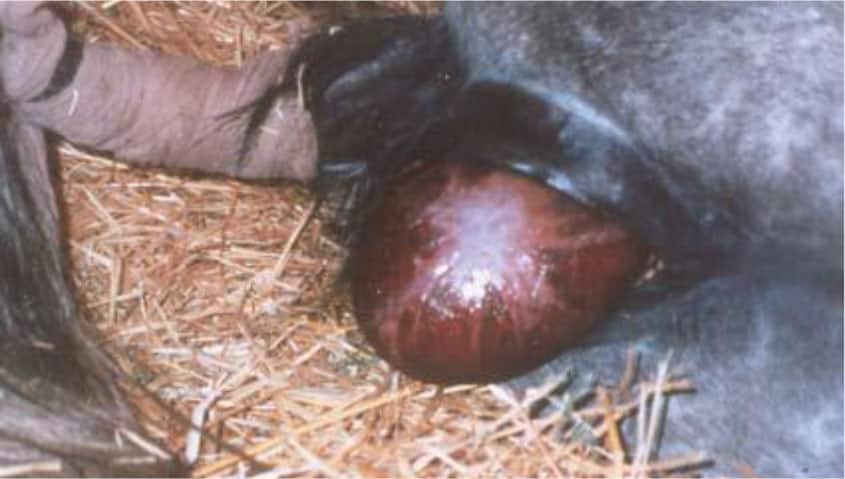
Stages of a Mare Foaling
First Stage Labour
During the early stages of labour, it is not unusual for the mare to get up and down several times. She is typically repositioning the foal in the birth canal, or may simply be uncomfortable!
Foaling can be a test of patience. Mares have been known to remain in this stage for several hours. Monitoring is recommended, (keeping your distance) and if in doubt, consult your vet.
Biting at the flanks or looking at her abdomen can appear to be similar to the signs of colic. Mares will also urinate frequently during this stage as there is a huge pressure on the mare’s bladder.
This stage ends when the mare ‘breaks water’.
Within 20 minutes of the ‘water breaking’ (passage of the allantoic fluid), the white amniotic membrane should become visible, it should be white/grey in colour. If at this stage you notice the membrane to be red as opposed to white call us immediately, 6241 8888. This is called a ‘red bag’ delivery and is a sign that the normal site of rupture is too thick and the mare is separating her placenta to expel the foal. The foal needs the placenta to be attached to the mare’s uterus at this time to allow oxygen to pass across from the mare’s blood, i.e. it needs the placenta to ‘breathe’.

Passing of the allantoic fluid, or ‘breaking water’. Note the white/grey colour of the membrane, visible at the vulva (above) compared with the “red bag” emergency (left).
Second Stage Labour
 Within the white membrane, you should now see the appearance of a foot, followed shortly by another foot, and then the nose.
Within the white membrane, you should now see the appearance of a foot, followed shortly by another foot, and then the nose.
Imagining if the mare is standing upright, both feet need to be presented with the bottom of the soles facing the ground and the nose lying on top of the legs, under the mare’s tail.
Call us if:
- The mare is straining but nothing appears.
- You notice the membrane to be red as opposed to white.
- You have seen the appearance of the white membrane, and no foot within 20 minutes.
- A foot and no second foot or the nose within 15 minutes.

You may be looking at a dystocia (malpresentation) situation, and time is of the essence to achieve a healthy outcome for both mare & foal.
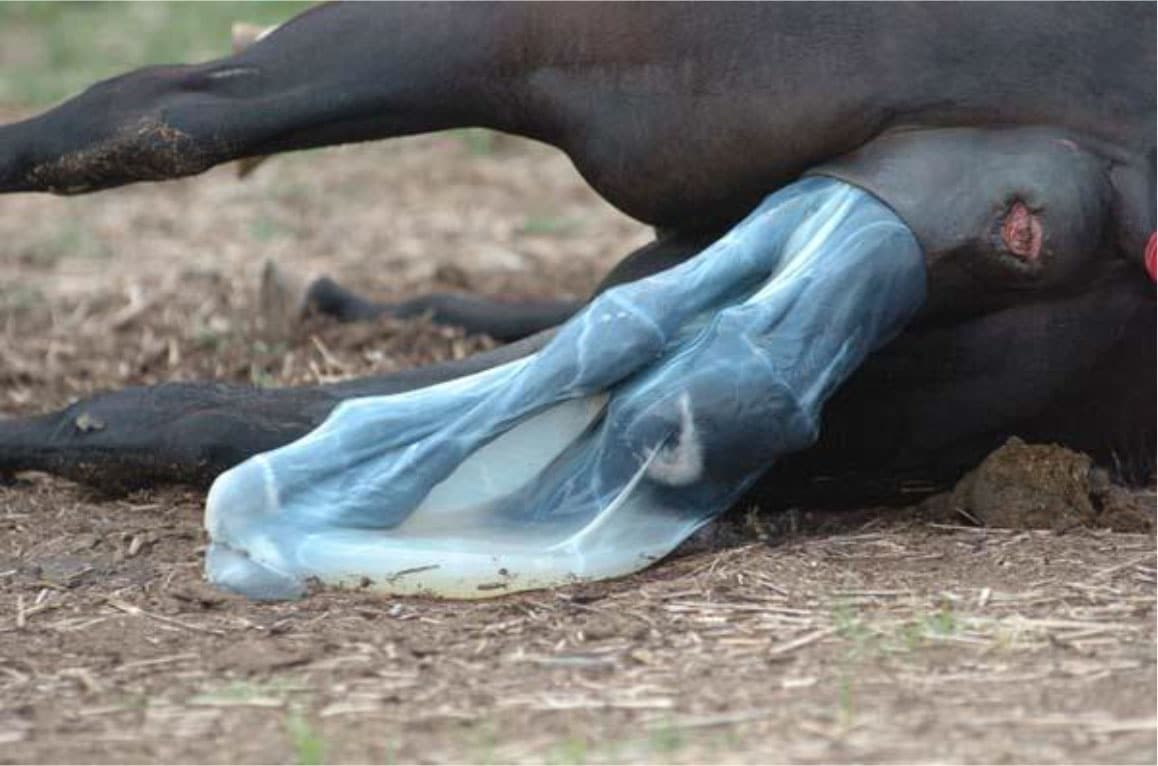

What you should be seeing during first stage labour, as described (left).
Once the front feet, head and neck are presented in this manner the foaling should continue to progress. Once the foal’s shoulder has passed, the mare may rest for a few seconds before continuing to push the foal out.
Second Stage Labour (continued)


 Notice the natural passage of the foal towards the mare’s hocks (above).
Notice the natural passage of the foal towards the mare’s hocks (above).
Once the foal is out of the mare, manual rupture of the amniotic membrane should be performed if it has not naturally occurred,otherwise the foal will suffocate (right).
Apart from this, you should have no other interference with mare or foal, and allow them bonding time.
Do not disturb the mare or attempt to move the foal from behind the mare. The foal will continue to receive blood from the mare via umbilicus for several minutes after birth, until the cord has ruptured.
Premature rupture of the umbilicus will result in blood loss, which can be life threatening. The mare will break the cord when she stands when she is ready. This may take 10 – 20 minutes.
Observe from a distance, ensuring both mare and foal display normal post foaling behaviours.

Above and right: Allow the mare and foal bonding time.
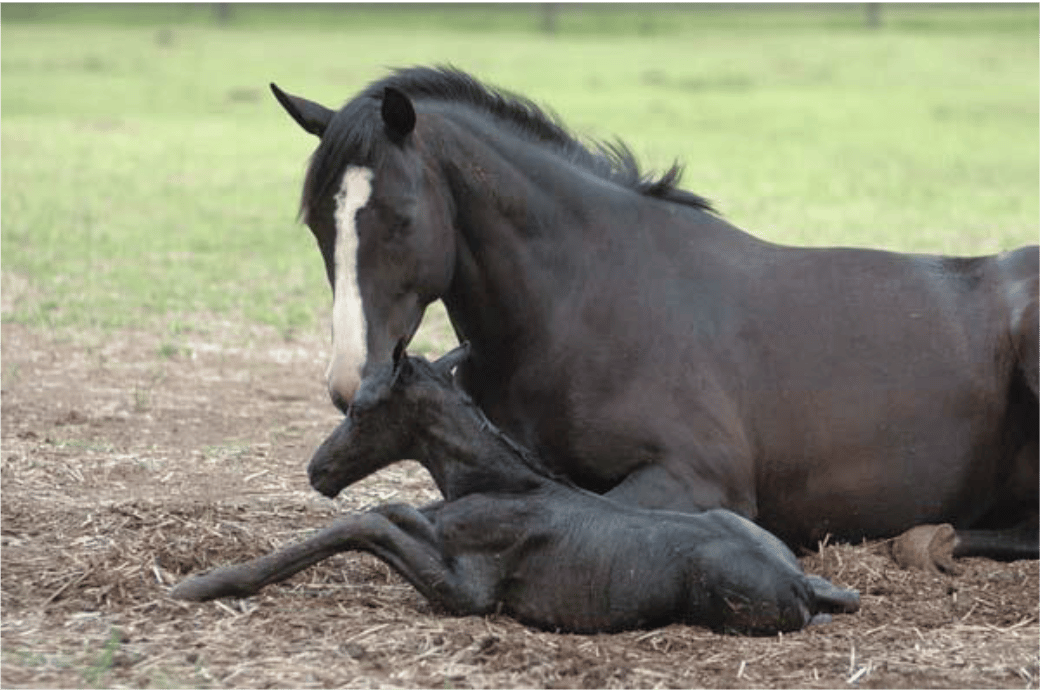
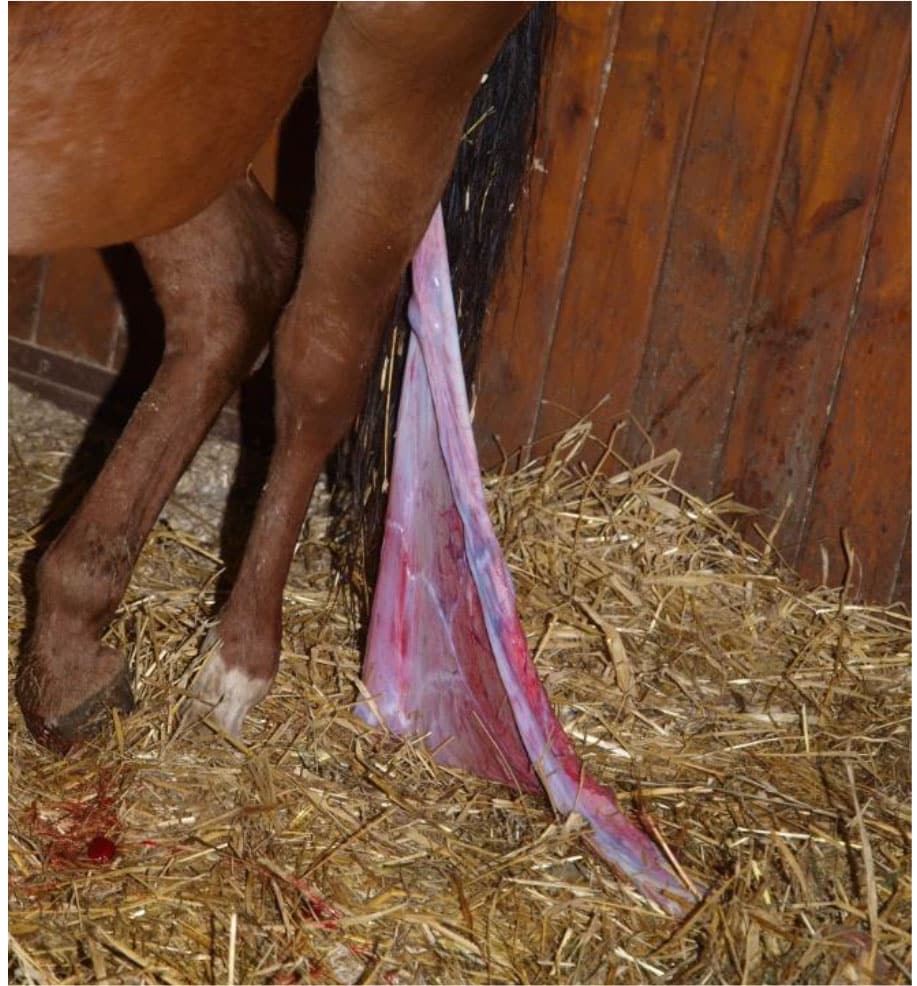
Note the placenta hanging from the mare before it has been completely passed.

Above and below: A normal, healthy placenta.

Third Stage Labour
During this stage after the birth of the foal, the uterus contracts, which can cause the mare discomfort until the placenta is passed. Call us if pain persists for more than an hour or gets progressively worse.
When the mare stands, the placenta should be tied up into a ball so that it does not flap around the mare’s hocks and frighten her and she does not walk on it and tear it. The extra weight of the knot will help its gradual separation from the mare’s uterus. Never try and pull the placenta yourself as this can lead to pieces breaking off and being retained within the uterus leading to infection.
When the placenta drops from the mare it should be checked carefully to make sure it is complete – with only one hole and no obvious signs of breakage or tearing – and none has been retained inside the mare.
The placenta is normally passed within one to four hours of foaling. If the placenta has not come away by three hours your veterinarian should be called.
Retained placenta is an emergency – it can result in infection of the uterus, toxaemia, laminitis and even death of the mare.
Call us if:
- The mare shows any signs of pain or colic post foaling.
- The placenta has not passed within three hours.
- You suspect your mare has retained any piece of her placenta.
- You are unsure how to check the placenta after it has passed.
Once the foal has been delivered:
- The foal needs to be sitting up and shaking its head within 30 – 60 seconds.
- Suck reflex needs to be present by 20 minutes.
- The foal needs to be attempting to stand by 20 minutes.
- The foal should be standing and walking by 90 minutes.
- The foal needs to be suckling from the mare before 150 minutes.
- The foal needs to pass the first meconium (first black faeces) within four hours after birth. You may need to look around in the paddock if there is no evidence on the foal. More meconium should pass during the next 12 – 24 hours.
- The foal should urinate within four to five hours.

The foal needs to be suckling from the mare within 150 minutes.

The meconium can be difficult to find –you may need to look around the paddock.


Apply diluted antiseptic solution to the navel soon after birth, then twice daily for the next few days.
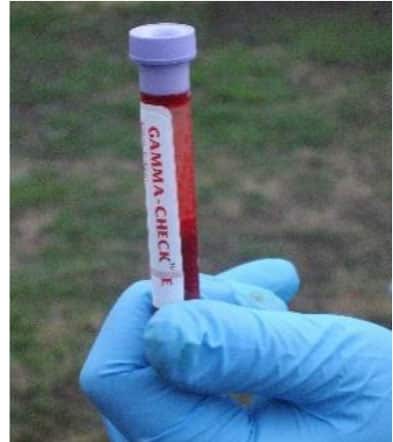
The IgG test should be done before 24 hours of age.
Caring for your Newborn
Navel
Dilute iodine or chlorhexidine needs to be applied to the foal’s umbilicus (navel) shortly after birth, once the foal is up and walking. Repeat application is ideal twice daily for the following few days, to reduce the risk of infection. We can supply you with these solutions, and show you how to apply.
Colostrum and Passive Transfer
A newborn foal is entirely dependent on maternal antibodies absorbed following ingestion of colostrum from the mare in the first few hours of life. This provides the best immune protection for any newborn foal.
Failure of the passive transfer of maternal antibodies (or FPT) can happen if the foal does not drink enough colostrum during the critical first few hours of life, or if the mare has produced colostrum of poor quality. FPT puts the foal at significant risk of infectious diseases, and even death. The success of passive transfer can be monitored by measuring levels of IgG (Immuno gamma globulin) in the blood of the neo natal foal. Detection of FPT is critical, and allows early intervention and treatment if required.
We strongly recommend that all foals have an IgG test done by a veterinarian before 24 hours of age. This is an inexpensive, non – invasive procedure that is essential to your foal’s wellbeing.
Veterinary Examination

A veterinarian should examine the mare and foal within 24 hours of birth.
Call a Veterinarian if . . .
Call us on 6241 8888 if you notice any of the following:
During the stages of labour:
- The mare is straining while trying to give birth, but nothing appears.
- The first thing you see coming out of the mare’s vulva is red to dark red as opposed to grey/white.
- The foal’s head and feet are not presented as previously described.
- The foal is not out within half an hour of first appearing.
- The foal is not breathing properly and/or not sitting up within 30 seconds to a minute.
- The mare shows any signs of pain or colic post foaling.
- The foal is not standing within 90 minutes.
- The foal appears to have leg issues that prevent it from standing normally.
- The foal is not drinking from the mare within 150 minutes.
- The placenta has not passed from the mare within three hours.
Once the foal has stood and is drinking from the mare:
- The foal has not passed any manure within four hours, and/or not urinated within four to five hours.
- The foal becomes listless and/or is no longer suckling several times per hour.
- There is milk running out of the foal’s nose and/or the foal has lots of milk on its face.
- The mare’s udder becomes engorged, indicating that the foal is not suckling adequately.
- There are any signs of swelling or heat in the foal’s legs.
- The foal’s eyelashes appear to be turned inwards, so the eyelashes are rubbing at the eye, which can result in corneal ulcers.

At any stage if you’re concerned about your mare or foal, please don’t hesitate to call our veterinarians, any time, day or night! 6241 8888.
